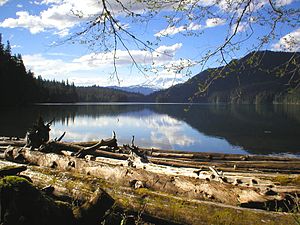Packwood Lake
| Packwood Lake | ||
|---|---|---|

|
||
| Mount Rainier as seen from the south end of the lake | ||
| Geographical location | Lewis County , Washington (USA) | |
| Tributaries | Upper Lake Creek, Lower Lake Creek | |
| Drain | Lake Creek → Cowlitz River | |
| Location close to the shore | Packwood | |
| Data | ||
| Coordinates | 46 ° 35 ′ 9 ″ N , 121 ° 33 ′ 32 ″ W | |
|
|
||
| Altitude above sea level | 871 m | |
| length | 3.2 km | |
| width | 1 km | |
| Maximum depth | 49 m | |
The Packwood Lake is a freshwater -See in the Gifford Pinchot National Forest in the Cascade Mountains of Washington . It is located near the small town of Packwood in a popular hiking and camping area. The southern half of the lake is in the Goat Rocks Wilderness .
The lake was named after William Packwood, an early settler in the area.
geology
Packwood Lake is located about 871 m above sea level and about 40 km southeast of Mount Rainier . The main source of its water are the glacier-fed Upper and Lower Lake Creeks, which flow from Gilbert Peak (also known as Old Snowy Mountain). The lake is about 3.2 km long and one kilometer wide.
The lake is dammed by a natural dam. About 1,200 years ago, Snyder Mountain, which borders the lake in the northwest, broke apart and the debris slid into the Lake Creek Valley, clogging it and finally forming the lake. The maximum depth is about 49 m. The only island in the lake is officially called Agnes Island, but is also called Wizard Island or Enchantment Island by local residents. The island is protected by the US Forest Service ; Landings are not allowed.
biology
Packwood Lake is home to a genetically separated species of rainbow trout . The fish have been spatially separated from other populations for more than a thousand years and have undergone their own evolution . They are known for their excellent taste, size and uniform cream color. However, due to many years of fish stocking, these trout are becoming less and less popular as the stocking fish changed the gene pool .
The lake is also home to several bird species, including herons , bald eagles and wood ducks . Black bears are as common as deer , elk , raccoons , pumas and (in the high areas above the lake) mountain goats .
history
Packwood Lake was used by Indians as a summer residence and hunting area for thousands of years . Because of the extremely cold winters and heavy snowfalls, the region is considered uninhabitable in winter.
In the early 1920s, prospectors did a thorough study of the area around the lake. Although some gold and silver deposits have been proven, the mining is not economically viable because the minable quantities are too small and the area is too remote.
Packwood Dam
Packwood Lake was built with a dam in 1964 to produce electricity . There is a small 27 megawatt generator at the foot of the lake; the dam has taken over the retention function of the landslide from Snyder Mountain. Great care was taken in the design and construction of the dam in order to minimize the impact on animals and plants in the vicinity of the dam. The current dam is only a few feet high and forms only a small reservoir to supply the pressure tunnel .
Water from Packwood Lake is also pumped to the town of Packwood and serves a larger area around Packwood.
tourism
Packwood Lake is a popular hiking destination for day trippers and campers. The trail leading to the lake , Packwood Lake Trail # 78, is also a popular gateway to the Goat Rocks Wilderness and its surroundings. The lake is also used as a stopover by travelers on their way to Mosquito Lake and Lost Lake in the north or Gilbert Peak in the southeast.
A few years ago an ATV trail (the 'lower trail') was completed, which also gives horses access to the lake. The 'upper trail' is reserved for hikers and riders. Both trails lead over 8 km to the lake from a paved and well-maintained parking lot. Continued beyond the lake, they offer hikers hundreds of miles of hiking trails through breathtaking scenery; the Pacific Crest Trail can be reached approximately 7 miles across the lake.
The lake itself is a popular destination for anglers who operate from the shore or from paddle boats ( internal combustion engines are prohibited). Fishing with bait (except artificial bait ) is also prohibited; all baits may only have one hook .
Individual evidence
- ^ Packwood Lake in the Geographic Names Information System of the United States Geological Survey
- ^ Edmond S. Meany: Origin of Washington geographic names . University of Washington Press, Seattle 1923, p. 205.
